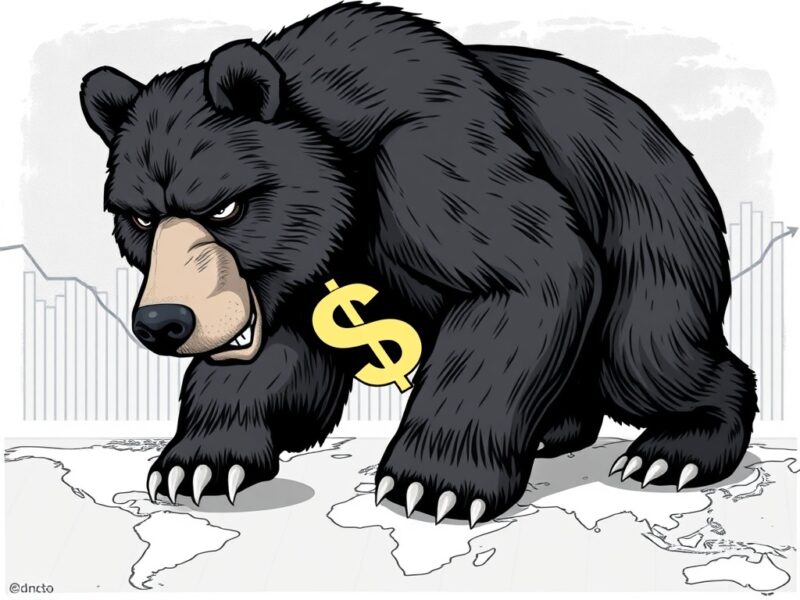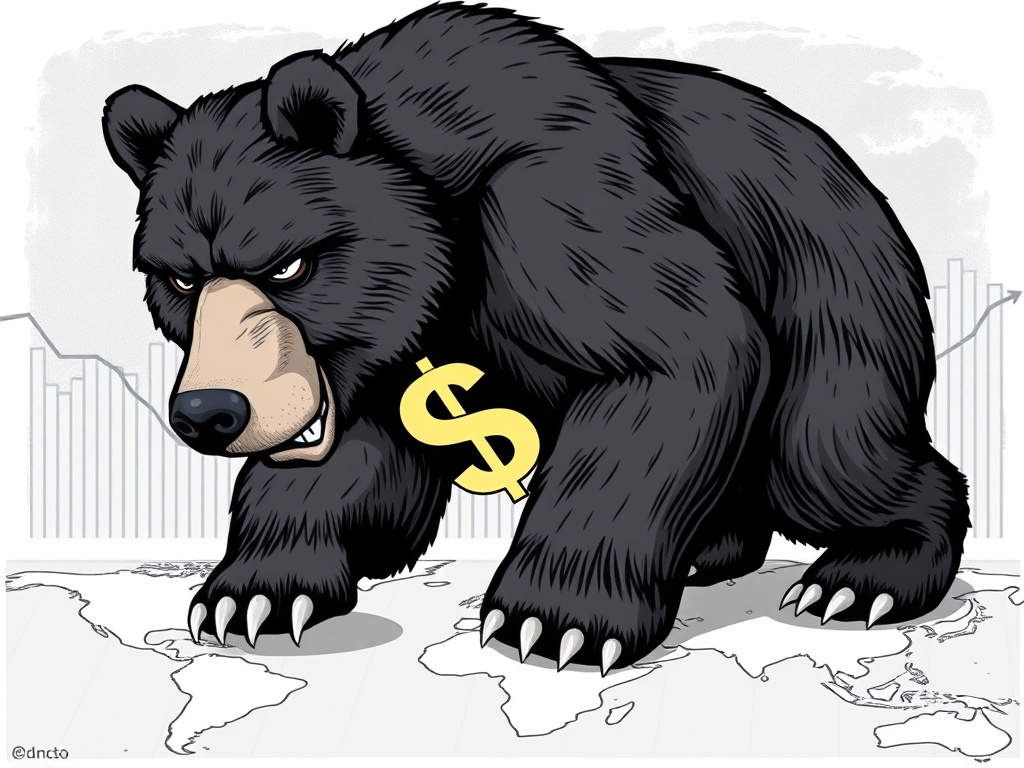US Dollar’s Persistent Plunge: Morgan Stanley’s Crucial Warning for Global Markets
0
0

BitcoinWorld

US Dollar’s Persistent Plunge: Morgan Stanley’s Crucial Warning for Global Markets
In the dynamic world of cryptocurrency, understanding macro-economic shifts is paramount. A major development making waves across financial markets is the persistent weakening of the US Dollar. What does it mean for your digital assets when a financial titan like Morgan Stanley declares the Dollar bear market is far from over? This isn’t just about traditional finance; it’s about the global liquidity, investor sentiment, and the very foundations upon which crypto markets operate. Prepare to delve into a crucial analysis of the dollar’s trajectory and its ripple effects.
The Unyielding Pressure on the US Dollar: What’s Driving the Downturn?
For months, financial analysts have debated the future of the US Dollar. While some predicted a rebound, Morgan Stanley has taken a firm stance, reiterating its long-held view that the dollar’s downward trend is set to continue. This isn’t a new phenomenon, but rather an ongoing narrative shaped by several fundamental factors. Understanding these drivers is key to anticipating market movements.
- Interest Rate Differentials: As other central banks, particularly in Europe and Asia, begin to tighten monetary policy or signal future hikes, the interest rate advantage previously held by the U.S. has diminished. This makes holding other currencies more attractive.
- Inflationary Pressures: While the Federal Reserve has aggressively hiked rates, persistent inflation in the U.S. continues to erode the purchasing power of the dollar, contributing to its weaker stance against other currencies.
- Global Economic Rebalancing: The post-pandemic recovery has seen other major economies gain momentum, reducing their reliance on the U.S. economy and, by extension, the dollar’s dominance. This rebalancing act naturally puts downward pressure on the greenback.
- Fiscal Deficits and Debt: The sheer scale of U.S. government debt and ongoing fiscal deficits can be a long-term drag on currency strength, as investors weigh the implications for future economic stability.
These factors collectively paint a picture of an environment where the dollar faces significant headwinds, making it challenging for any sustained rally to take hold. Investors need to be acutely aware of these underlying currents.
Why the Dollar Bear Market is Far From Over, According to Morgan Stanley
Morgan Stanley’s conviction about the enduring Dollar bear market isn’t based on fleeting trends but on deep-seated structural shifts. Their analysts point to a confluence of macroeconomic indicators and policy outlooks that suggest the current depreciation is more than just a cyclical dip. This perspective challenges those who believe the dollar might soon find a floor and reverse course.
The investment bank highlights that while the Federal Reserve might be nearing the end of its tightening cycle, other central banks still have room to catch up. This divergence in monetary policy paths is a critical component of their thesis. Furthermore, the persistent current account deficit in the U.S. means there’s a continuous outflow of dollars, creating a fundamental supply-demand imbalance that favors other currencies.
Consider the historical context: major currency cycles often last for years, not months. If the dollar entered a bear market phase some time ago, its full unwinding could still be a considerable journey. Morgan Stanley’s analysis suggests that the market has not yet fully priced in the long-term implications of a less dominant U.S. economy on the global stage, further fueling their bearish outlook.
Decoding the Morgan Stanley Forecast: What Does it Mean for Global Investors?
The weight of a Morgan Stanley forecast carries significant influence in financial circles. Their bearish outlook on the dollar has profound implications for a wide array of asset classes and investment strategies. For global investors, this isn’t merely an academic exercise; it’s a call to action to re-evaluate portfolio allocations and risk exposures.
Impact on Different Assets:
| Asset Class | Potential Impact of Weak Dollar | Why? |
|---|---|---|
| Commodities (e.g., Gold, Oil) | Generally positive | Priced in dollars, a weaker dollar makes them cheaper for holders of other currencies, increasing demand. |
| Emerging Markets (Stocks & Bonds) | Positive | Reduces dollar-denominated debt burden, improves export competitiveness, attracts foreign investment. |
| U.S. Equities (especially multinationals) | Mixed to positive | Boosts overseas earnings when repatriated, but can make U.S. exports more expensive. |
| Cryptocurrencies (e.g., Bitcoin, Ethereum) | Potentially positive | Often seen as an alternative store of value, especially in times of fiat currency weakness or inflation concerns. Increased liquidity could flow into crypto. |
| Non-U.S. Equities (Europe, Asia) | Positive | Stronger local currencies boost returns for dollar-based investors, improved competitiveness. |
This table illustrates how a weakening dollar can create tailwinds for certain assets while posing challenges for others. Investors must consider these shifts when constructing diversified portfolios.
Navigating the Volatile Forex Market: Opportunities and Risks
The Forex market, or foreign exchange market, is the direct battleground for currency strength. A persistent dollar bear market means increased volatility and potential for significant moves in major currency pairs. For traders and investors active in forex, this presents both substantial opportunities and heightened risks.
Opportunities:
- Long Non-Dollar Currencies: Betting on the appreciation of currencies like the Euro (EUR), Japanese Yen (JPY), British Pound (GBP), or commodity-linked currencies (AUD, CAD) against the dollar.
- Carry Trades: If interest rate differentials widen further in favor of non-dollar currencies, carry trades (borrowing in low-yield currency, investing in high-yield currency) could become more attractive.
- Hedging Strategies: U.S.-based companies with significant international operations may benefit from hedging their foreign currency exposures to capitalize on a weaker dollar.
Risks:
- Sudden Reversals: While Morgan Stanley’s view is strong, unexpected geopolitical events or drastic policy shifts could trigger temporary dollar rallies, catching unprepared traders off guard.
- Increased Volatility: Bear markets are often characterized by choppier price action, requiring more robust risk management strategies.
- Liquidity Issues: In extreme scenarios, rapid currency movements can lead to temporary liquidity issues in certain pairs.
A disciplined approach, incorporating thorough technical and fundamental analysis, will be crucial for success in this environment. The forex market demands vigilance and adaptability.
The Wider Implications for the Global Economy and Crypto Adoption
A weakening US Dollar has far-reaching implications for the entire global economy. Its status as the world’s primary reserve currency means its movements ripple through international trade, debt, and capital flows. For the cryptocurrency space, these macro shifts are particularly relevant, as they can influence investor appetite for alternative assets.
How a Weak Dollar Impacts the Global Economy:
- Boost for Emerging Markets: Many emerging market nations hold dollar-denominated debt. A weaker dollar makes it cheaper to service this debt, freeing up capital for domestic investment and growth.
- Shift in Trade Balances: U.S. exports become more competitive, while imports become more expensive, potentially narrowing the U.S. trade deficit. Conversely, other nations’ exports to the U.S. may face headwinds.
- Inflationary Pressures Abroad: For countries that import significant goods priced in dollars, a weaker dollar could mean lower import costs, potentially easing inflationary pressures.
- Reshaping Reserve Holdings: Over time, a sustained dollar decline could encourage central banks to diversify their foreign exchange reserves away from the dollar, further reducing its global dominance.
The Crypto Connection:
For cryptocurrencies, a persistent dollar bear market can be a significant catalyst. When traditional fiat currencies show signs of weakness, investors often seek alternative stores of value. Bitcoin, often dubbed “digital gold,” benefits from this narrative. Furthermore, a weaker dollar can lead to increased global liquidity, which historically has found its way into riskier assets, including crypto.
The flight from fiat currency instability or inflation concerns can drive adoption and investment into decentralized digital assets. This doesn’t mean a direct 1:1 correlation, but it certainly adds to the bullish narrative for cryptocurrencies as a hedge against traditional financial system vulnerabilities.
Navigating the Shifting Sands: What Comes Next?
Morgan Stanley’s resolute stance on the ongoing Dollar bear market serves as a powerful reminder that macroeconomic forces are constantly at play, reshaping investment landscapes. From the intricate dynamics of the Forex market to the broader currents affecting the global economy, the dollar’s trajectory is a central theme for all investors. Whether you’re deeply entrenched in traditional assets or exploring the frontiers of cryptocurrency, understanding these shifts is not just beneficial—it’s essential for strategic decision-making.
The message is clear: adapt or be left behind. As the US Dollar navigates this challenging period, astute investors will look for opportunities in commodities, emerging markets, and potentially, the burgeoning world of digital assets. The time to assess your portfolio’s resilience against a weakening dollar is now, ensuring you are positioned for what could be a prolonged period of currency rebalancing.
To learn more about the latest Forex market trends, explore our article on key developments shaping the US Dollar and global liquidity.
This post US Dollar’s Persistent Plunge: Morgan Stanley’s Crucial Warning for Global Markets first appeared on BitcoinWorld and is written by Editorial Team
0
0
 Manage all your crypto, NFT and DeFi from one place
Manage all your crypto, NFT and DeFi from one placeSecurely connect the portfolio you’re using to start.






